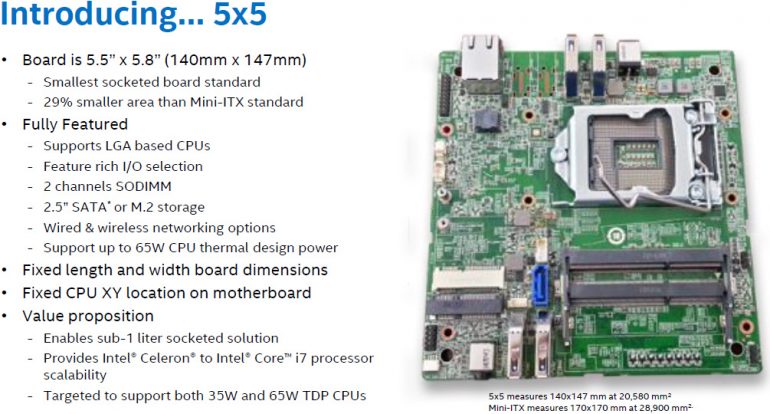The clear trend in PC computing of offering smaller and smaller PCs has resulted in two main form factors – Intel’s NUC, which offers decent performance and the mini-ITX form factor. While NUC is really small and features very low power consumption, NUC-based PCs cannot be upgraded. The opposite is true for mini-ITX – PCs based on this technology can be upgraded but are considerably larger. Clearly a new form factor is needed.
This is exactly what Intel has proposed. Called 5 x 5 the new form factor combines performance, upgradeability and small size. The main component in 5 x 5 is the mainboard that measures 140 x 147 mm (5.5 x 5.8 inches) with the entire 5 x 5 platform being about 39 mm high and having around 0.85 liters of volume. The mainboard has an LGA socket, two SO-DIMM memory slots, an M.2 connector for solid-state drives, a port for Wi-Fi/Bluetooth cards, a SATA port, two USB 3.0 connectors, Gigabit Ethernet, two HDMI ports and other peripherals that you can expect from a modern motherboard. The downside – 5 x 5 is larger than NUC but can be upgraded.
Intel says the new 5 x 5 platform will support all Intel processors with TDP of 35W or 65W, which gives builders a wide choice when it comes to processors. Sadly, these boards do not have PCI-E connectors for video cards so users will have to live with Intel’s integrated graphics. This is what will make gamers skip this platform but it will have a punch for sure.
In addition to this 5 x 5 will require new PC chassis and new CPU coolers but the tradeoff is that system builders will have a lot of flexibility, which is something that NUC does not offer. The first 5 x 5 motherboard to hit the market will have the newest Intel LGA 1151 socket for Skylake processors and likely Intel’s Alpine Ridge controller that supports USB 3.1 Type-C and Thunderbolt connectivity.
The first 5 x 5 systems will likely be on the market next year. No word on pricing as of now.
Source: Liliputing.com
